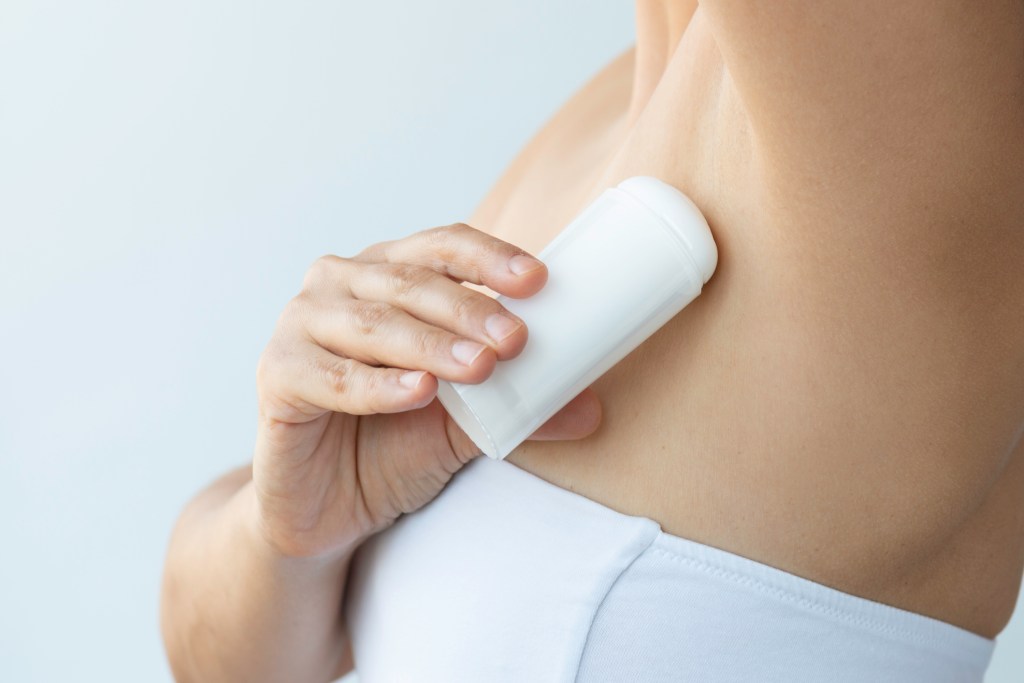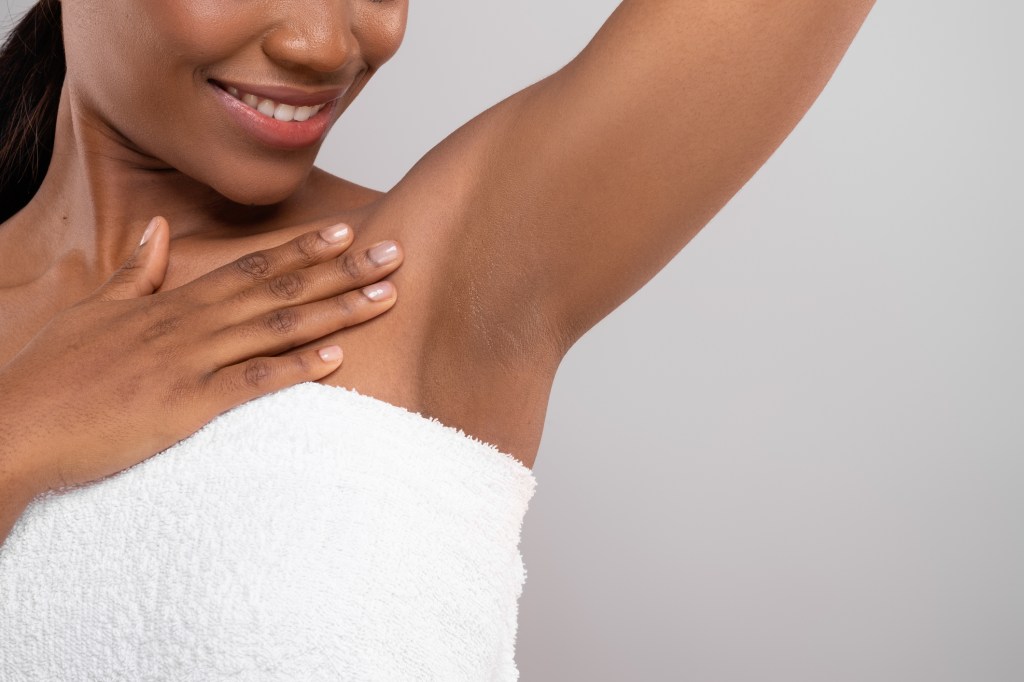Armpit Detox: Why Dermatologists Say You Should Give Your Underarms Some TLC + How to Do It
All it takes is 3 simple steps!

Once more associated with trendy juice cleanses than anything else, the word “detox” has slowly but surely crept into the beauty world. There are skincare detoxifying treatments that deep-clean your pores and hair masks to purify your scalp and strands, but it’s the concept of an armpit detox that has the internet buzzing. Googling the term yields over a million results — and it’s also a trending topic on social media. But just as other detoxes can be somewhat controversial, so too is an armpit detox. The question at hand: Is it really necessary? Does it do anything that the body can’t do itself? We tapped top dermatologists to explain exactly what an armpit detox is, plus weigh in as to whether this is a trend worth trying.
What is an armpit detox?

Armpit detoxing is considered to be a type of “rehab” for skin that’s been loaded up with pore-clogging fragrance, chemicals and other ingredients from applying antiperspirants or deodorants, explains Alicia Zalka, MD, a board-certified dermatologist, associate clinical professor of dermatology at Yale University and the founder of Surface Deep. Think of it as an armpit facial or deep cleanse for those frustrated with persistent odor, dullness or discoloration, or an irregular texture on the skin under their arms, she adds.
More often than not, armpit detoxes come up in the context of people switching up the products they’re using. “When people make the change from traditional antiperspirants to deodorants, they may notice that they’re smellier than usual. The idea is that an armpit detox can help make this transition easier,” notes Hadley King, MD, a board-certified dermatologist in New York City. (Just as a reminder, antiperspirants contain ingredients that actually block sweat from coming out onto the surface skin, whereas deodorants simply absorb moisture and mask odor but don’t actually keep you from sweating.)
There are different ways to do an armpit detox, ranging from DIY treatments to underarm masks, but in general, an armpit detox involves discontinuing the use of whatever antiperspirant or deodorant you’re using, exfoliating and then re-balancing the skin’s pH, says Dr. Zalka. (More on the specifics for how to do an armpit detox below.)
Why should I do an armpit detox?
Consider it if you simply want to give the skin under your arms a little bit of a break. One of the most legitimate benefits of an armpit detox is that it’s a good way to give this area a bit of dedicated TLC. “Antiperspirants block sweat by forming an actual plug in the skin’s sweat ducts,” says Dr. Zalka. “Deodorants mask odors with perfume and may contain ingredients to absorb moisture. Both of these can build up and leave a residue over time, and some people may even develop rashes, skin thickening, discoloration or pimples.” An armpit detox can help soothe the skin and improve its overall appearance, she notes.

As far as an armpit detox helping to minimize odor, if you’re transitioning from an antiperspirant to a deodorant, that benefit isn’t entirely substantiated. That’s because it’s the bacteria under your armpits that causes an unpleasant scent, not the sweat itself. “Any time you change your usual armpit routine, it takes time for this bacteria to balance out and you may experience more odor,” explains Dr. King. Doing an armpit detox may help remove some of this odor-causing bacteria, but something as simple as using soap and water can also have the exact same effect, she points out.
What an armpit detox can’t do is pull out toxins from your body, a point underscored by both dermatologists we spoke with. “I don’t think there’s any validity to the claims that an armpit detox mask can help remove toxins from your lymph nodes and body,” says Dr. King. Dr. Zalka agrees. Your body naturally detoxifies impurities through organs such as the liver and kidneys, she says.
How to do an armpit detox

First, a few important caveats. Remember that, if you’re going to discontinue using an antiperspirant, expect an uptick in sweat while you do an armpit detox. According to Dr. Zalka, this is totally normal and expected. However, it may not be as noticeable if you’ve hit menopause. “Post menopause, both sweat and odor may actually diminish because the hormones that stimulate the sweat glands in the underarms decrease,” she explains.
Secondly, remember that the skin in this area is delicate and sensitive, and overdoing your detoxing can actually end up doing more harm than good. The underarms are delicate and withstand shaving and other hair removal practices, as well as experience friction from clothing and normal arm motion, says Dr. Zalka. Detoxifying incorrectly can actually end up causing even more irritation.
Step 1: Exfoliate skin
Start with a dedicated underarm exfoliation. Dr. Zalka suggests either dry brushing (we like the convenient size of Bare Botanics Exfoliating Dry Brushing Body Brush) or using a body scrub designed specifically for this sensitive spot, like Pacifica Coconut & Charcoal Underarm Detox Scrub.
Step 2: Apply a mask
Slathering on an underarm mask comes next. Dr. Zalka likes Megababe Happy Pits Detoxifying Underarm Mask, which contains purifying charcoal and skin-brightening vitamin C. Or, try Pure Pits Organic Armpit Detox, which combines detoxifying charcoal and bentonite clay along with soothing calendula. Most masks are meant to be left on for about 15 minutes before being rinsed off, but follow the directions of any particular product you’re using.
Step 3: Dab on apple cider vinegar

Finally, reach for some apple cider vinegar. Yes, the stuff in your kitchen cabinet. Why? “The residue from deodorant and antiperspirant can throw off the pH of your skin and make it more alkaline. Using apple cider vinegar helps lower that to a more skin-friendly pH,” explains Dr. Zalka.
To do: Dilute equal parts of ACV with cool water, dip a wash cloth into the mixture, then dab that under your arms after you’ve showered. You’ll know you’ve used enough when the area feels slightly moist, says Dr. Zalka. Keep in mind that vinegar can be irritating to the skin, so diluting it with water is paramount, cautions Dr. King. As part of the detox, you’ll also want to discontinue use of your current antiperspirant or deodorant for a few days.
For an in-depth tutorial on an armpit detox, watch the below video from @jadesworldtv on YouTube.
Things to keep in mind about armpit detoxes
If you really want to try an armpit detox, there’s no harm in doing so — as long as you do so correctly and don’t end up inadvertently irritating this sensitive area. If nothing else, it can help improve the overall look and feel of the skin under your arms.
That being said, there’s also no urgent need to do an armpit detox. The good old fashioned combination of soap, water and a washcloth can help to both remove odor-causing bacteria and help remove a build-up of any unwanted products, says Dr. King. It also bears mentioning that if you’re dealing with lumps, bumps or rashes under your arms that simply aren’t going away, it’s always best to see your doctor rather than trying to take matters into your own hands, notes Dr. Zalka.
For more skin and hair care tips and tricks, click through these stories:
Repair Your Skin Barrier to Prevent Dryness, Redness and Breakouts
Hair Cycling Is the TikTok Trend That Can Make Your Hair Look Healthy, Shiny and Full



















